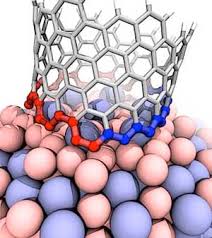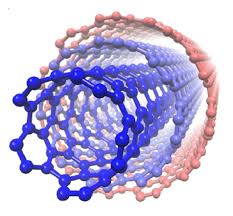How to separate SWCNTs nanotubes through covalent methods and wall functionalization (PhD in nano-microelectronics)
Researcher and author: Dr. ( Afshin Rashid)
Note: Separation of SWCNTs by covalent methods of functionalizing the wall of carbon nanotubes has a cylindrical structure with SP2. And the hybridization of their carbon atoms is related to the inactivity of the carbon nanotube exactly to the orbital adaptation of π due to curvature.
More activity of carbon nanotubes with smaller diameters than incremental reactions can be related to the intensification of spatial pressure. In addition, electrophilic selectivity reactions on SWCNTs are much easier to perform on metal nanotubes because they have higher HOMO levels . Selectivity in wall functionalization reactions Based on the knowledge of electron levels (DOS), it can be understood that this reaction plays an important role in the functionalization of the wall of carbon nanotubes. Unlike semiconductor SWCNTs, metal nanotubes have DOS electrons on the Fermi surface, and the Fermi surface is the chemical potential of the electrons. At zero temperature, this surface contains electrons, but in semiconductors, electrons are placed in the energy gap, in which there are no permissible energy levels. Therefore, electrons are present to stabilize the charge transfer complex formed by increasing the reactant to the surface of the nanotube. Metal SWCNTs can better stabilize the transducer and therefore increase the reaction speed. This may be due to the activity of metal SWCNTs in electrophilic additive reactions such as increasing dichlorocarbon and reactive carbon (ondiazonium) and increasing hydrosilytation . Reactions of SWCNTs with diazonium ions or salts have been performed so far , and for the first time water-soluble aryl diazonium reactants selectively work well with metal SWCNTs .
Diazonium salts convert metal SWCNTs into semiconductors by forming an aryl covalent bond on nanotubes . After heat treatment, nanotubes with azonium groups, metal nanotubes are recovered and aryl groups are separated from the nanotube walls. The presence of the diazonium functional group deactivates the metal nanotubes in electrical equipment because the covalent activation of the diazonium significantly disturbs the optical and electrical properties of metal SWCNTs. To optimize this reaction, more benzene salts are being investigated .
Conclusion:
Selective covalent functionalization of the walls of semiconductor SWCNTs due to the dipole reaction of increasing the cyclic azomethineylides obtained from trialkylamine-N oxides with polycyclic aromatics, causes the amount of metal nanotubes in the bottom of the container to increase. Theoretical studies show that the bipolar ring increase is sensitive to the diameter and chirality of nanotubes.
Researcher and author: Dr. ( Afshin Rashid)
PhD in Nano-Microelectronics




